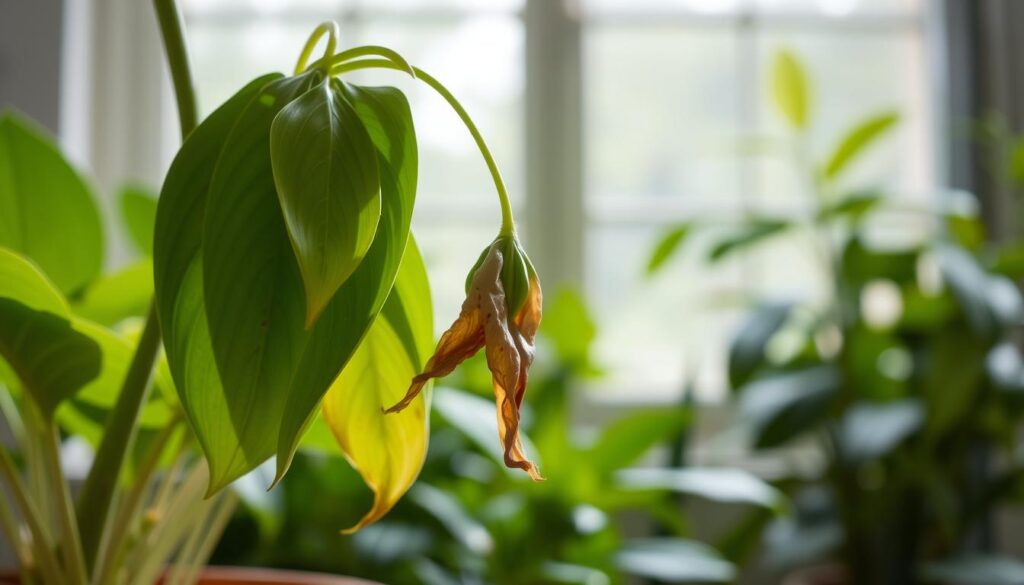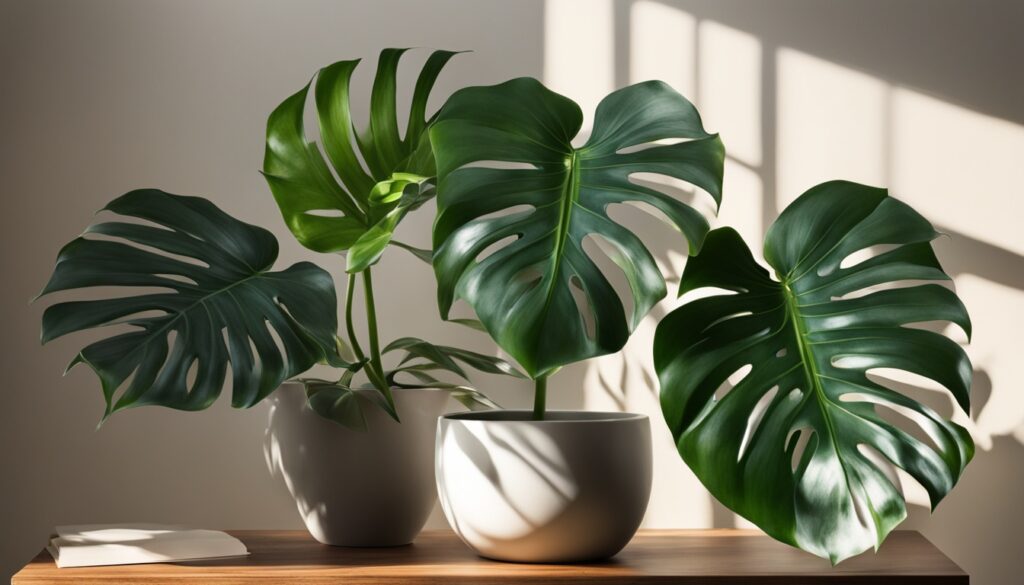Ever looked at your houseplant and seen its leaves wilting? It can be really upsetting. But don’t worry, there are ways to fix it. We’ll show you why your plant might be drooping and how to make it healthy again.
Key Takeaways
- Drooping leaves can mean many things, like too much or too little water, not enough light, or the wrong temperature.
- Finding out why your plant is drooping is key to fixing it.
- Changing how you water, making sure it gets enough light, and keeping it at the right temperature can help.
- Watching your plant closely and acting fast is important for keeping it healthy.
- Knowing about plant structure and how cells work can help you fix drooping plants.
By understanding why your plant is drooping and taking the right steps, you can make it healthy again. Let’s explore how to keep your houseplants looking great.
Learn more about the worryplant, a resilient and calming houseplant option
Understanding Plant Drooping: The Science Behind Wilting
Plant drooping is a common problem for gardeners and plant lovers. It happens when plants lose cell turgor, the pressure that keeps them upright. This loss of pressure makes leaves and stems weak and floppy. Knowing the science behind wilting helps us find and fix the causes of drooping plants.
Cell Turgor and Plant Structure
Plants stay firm and upright thanks to cell walls and internal pressure. This pressure comes from water moving into cells. When this balance is upset, plants start to droop.
How Plants Maintain Their Shape
Healthy plants balance water intake and loss well. But, high temperatures, low humidity, and wind can upset this balance. This leads to water loss and a drop in cell pressure, causing leaves and stems to droop.
Signs of Compromised Plant Health
Signs of a stressed plant include droopy leaves and floppy stems. Changes in soil moisture also affect plant health. Spotting these signs helps us fix the problems that cause drooping.
“Plants that are wilted usually look sad and droopy. Many food crops are prone to wilting, and lack of water for a longer period of time can result in the death of the plant.”
Exploring the science of plant drooping helps us solve this common issue. It lets us keep our plants healthy and strong.
Common Signs Your Plant Is Drooping
When a plant starts to droop, it’s a clear sign that something is wrong. By spotting the common signs of plant stress, you can fix the problem quickly. Watching for plant drooping symptoms is the first step to making it healthy again.
One obvious sign of plant trouble is limp, floppy leaves. This can happen if you water too much, making the leaves soft and soggy. Or, if you don’t water enough, the leaves will dry out and turn brown. You might also see yellowing or browning of the leaves, which means the plant might not have enough nutrients or is stressed.
- Wilting or drooping leaves
- Yellowing or browning of the foliage
- Overall plant limpness and stunted growth
Changes in soil moisture can also show that something is wrong. If the soil is too wet or too dry, it means the plant’s water needs aren’t being met. Spotting these plant stress indicators early can help you fix the problem and keep your plant healthy.
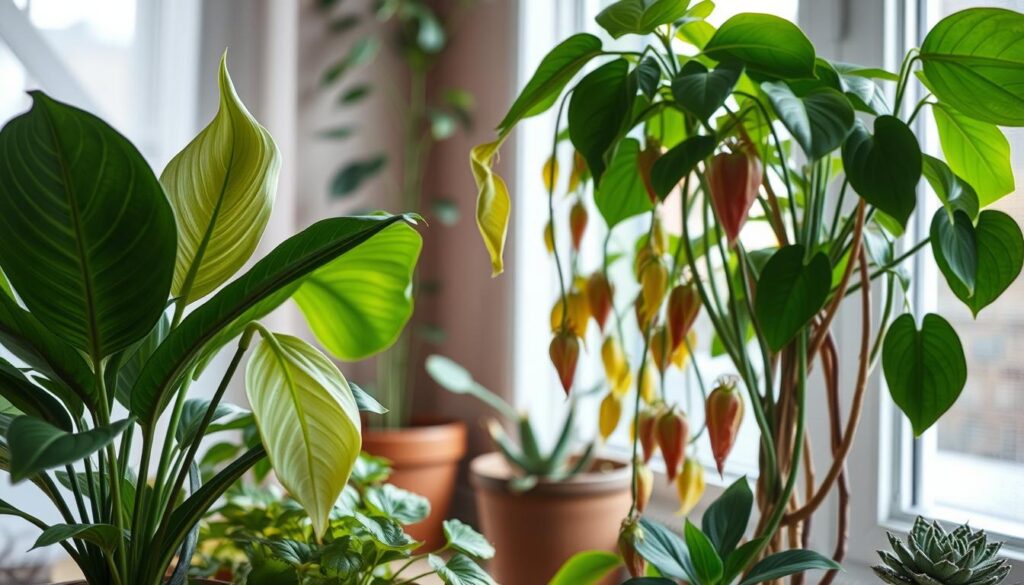
“Addressing the root cause of plant drooping is essential for restoring its vigor and preventing long-term damage.”
By watching your plant closely and acting fast when it shows signs of trouble, you can help it grow well. Remember, catching problems early is crucial for saving a drooping plant.
The Impact of Watering Issues on Plant Health
Getting the right amount of water is key for your plants’ health. Too much or too little water can cause droopy leaves. Knowing the signs and finding the right watering schedule is crucial for your Philodendron’s health.
Signs of Overwatering
Too much water is bad for plants. When the soil is always wet, roots can’t breathe. This leads to yellow, soft, and wilted leaves. It also encourages harmful fungi, harming the roots further.
Signs of Underwatering
Not enough water makes plants wilt and droop. Leaves become dry, crisp, and discolored, with curled edges. Underwatered Philodendrons struggle to stay green and lush.
Finding the Right Watering Balance
To keep your Philodendron healthy, water only when the top 2 inches of soil are dry. Change how often you water based on the season and your plant’s needs. Good drainage is key to avoid too much water and ensure roots get the right moisture. Watch the soil and your plant’s response to find the best watering schedule.
| Watering Issue | Symptoms | Solutions |
|---|---|---|
| Overwatering | Yellow, soft, and wilted leaves | Improve drainage, allow soil to dry out between waterings |
| Underwatering | Dry, crisp, and curling leaves | Increase watering frequency, monitor soil moisture |
“Consistent, proper hydration is the foundation for a healthy, thriving Philodendron. Paying attention to the signs and adjusting your watering practices accordingly can make all the difference.”
How Light Exposure Affects Plant Posture
Light is key for indoor plants to grow well. Too little light can make plants droop and look stressed. Too much sun can burn leaves and make them wilt.
To keep your plants happy, know their light needs. ZZ plants like low light, needing 50-150 micromoles per square meter per second. Most houseplants prefer 150-250 micromoles, while some need more than 1,000 foot-candles.
- LED grow lights are energy-efficient and last long, giving a wide range of light without too much heat.
- Fluorescent lights are a bit less energy-efficient but cost less upfront. They don’t last as long as LEDs.
- Incandescent bulbs are the cheapest but use a lot of energy and get hot.
- High-pressure sodium and metal halide lights give a lot of light over a big area, often used in big places.
Where you put your plants matters a lot for light exposure. South-facing windows have the most light. East and west windows have about 60% of that. North windows have only 20%.
Changing how far plants are from the light can also help. For young plants, keep them 4-6 inches away. For bigger plants, 12-24 inches is better.
“Increasing the duration of light exposure to plants can compensate for low light intensity as long as the flowering cycle is not sensitive to day length.”
Knowing how light stress affects plants is vital. Give them the right light to keep them healthy and prevent drooping. By matching their light needs, your plants will do well and avoid problems from too little or too much light.

Temperature Stress and Plant Drooping
Extreme temperature changes can harm plants, causing them to wilt and droop. As temperatures rise, temperature stress becomes a big problem for plant lovers and gardeners. It’s crucial to control the climate to prevent heat damage and help your plants grow well.
Optimal Temperature Ranges
Most plants like temperatures between 65-75°F (18-24°C). If the temperature gets too high or too low, plants can get stressed. This stress shows up as droopy leaves and wilting.
Heat Stress Solutions
- Keep plants away from direct heat, like windows and vents, to prevent moisture loss.
- Make sure plants have enough humidity to fight off dry heat.
- Water plants well and often, especially when it’s hot.
- Don’t fertilize plants when it’s very hot, as it can stress the roots more.
- Use shade cloth or move plants to a cooler spot to protect them from too much sun.
Cold Damage Prevention
Cold temperatures can also harm plants. Sudden cold or drafts can damage cells and make leaves droop. To avoid cold damage:
- Slowly get plants used to temperature changes, avoiding sudden shifts.
- Keep plants away from cold spots, like windows and doors.
- Watch for signs of cold stress, like wilting or color changes, and warm them up fast.
Knowing the best temperatures for your plants and using strategies to fight heat and cold stress helps. This way, your plants stay healthy and look great all year.
| Temperature Range | Impact on Plant Health |
|---|---|
| 65-75°F (18-24°C) | Optimal temperature for most houseplants and garden varieties |
| Above 110°F (43°C) | Rapid water loss and wilting due to excessive evaporation |
| Below 50°F (10°C) | Cellular damage and drooping leaves due to cold stress |
Root System Problems and Solutions
Healthy roots are key for a thriving plant. But, root issues can cause problems like plant drooping. A common problem is root-bound plants, where roots are too crowded and can’t absorb water and nutrients well.
Signs of a root-bound plant include roots circling the pot’s bottom or coming out through drainage holes. If you see these signs, it’s time to act. Repotting the plant in a slightly bigger pot with fresh, draining soil can help. This can solve the root congestion and promote better root growth.
When repotting, carefully trim any damaged or too-long roots. This helps the plant focus on growing a strong, robust root system. A strong root system is essential for the plant’s health and vitality.
| Common Root System Problems | Solutions |
|---|---|
| Root-bound plants | Repot into a larger container with fresh soil |
| Damaged or excessive roots | Carefully trim roots during repotting |
| Soil compaction | Aerate soil to improve drainage and oxygen flow |
By fixing root system problems and giving your plants the right conditions, they can recover from drooping. They will regain their vibrant, healthy look.
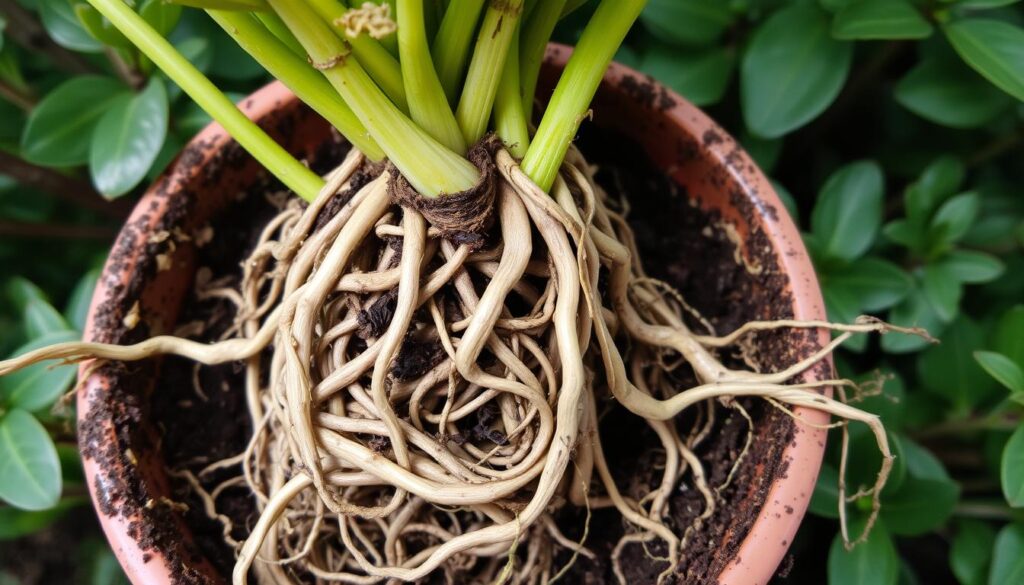
Identifying and Treating Root Rot
Root rot is a serious fungal infection that can harm plants. It causes leaves to turn yellow and plants to droop. If not treated, it can spread fast, making it hard for plants to get the nutrients and water they need.
Early Warning Signs
Checking your plant’s roots is key to spotting root rot early. Healthy roots are firm and white. Rotten roots are brown or black and soft. Look for stunted growth, leaf color changes, and an unhealthy look. Quick action is vital when you see these signs.
Treatment Methods
If your plant shows signs of root rot, start by removing it from its pot. Inspect the roots carefully. Cut off any bad roots with sterilized shears. Then, put the plant in fresh, draining potting mix. Water it lightly after repotting to avoid making things worse.
Prevention Strategies
- Choose a potting mix that breathes well, like one with sand, perlite, or bark.
- Don’t overwater your plants, as too much water can cause root rot.
- Repot your plants every few years to keep the soil fresh and prevent fungi buildup.
- Check the soil moisture often and adjust your watering as needed.
- Trim off any dead or dying leaves to help your plant use less water and nutrients.
Watch for root rot signs, treat your plants fast, and use prevention methods. This way, you can keep your garden healthy and thriving.
The Role of Soil Quality and Drainage
Keeping your soil quality and drainage in check is key for your plants’ health. Using the right soil can prevent your plants from drooping and wilting.
Poor soil or bad drainage can cause many problems. These include waterlogged soil, nutrient shortages, and root rot. To help your plants, use a potting mix that fits your plant’s needs. Adding perlite or sand can also help with drainage.
Testing your soil regularly can spot nutrient or pH problems. These issues can stress your plants and make them droop. Fixing these problems creates a better environment for your plants to grow.
| Soil Composition | Drainage Systems | Potting Mix |
|---|---|---|
| Well-draining, loamy or sandy soil is best for most plants. Avoid heavy, clay-based soils that can hold too much water. | Make sure your plant pots have enough holes for water to drain. Adding perlite or gravel at the bottom helps with drainage. | Choose a good potting mix that’s made for your plant’s needs. Don’t use garden soil, as it might not provide enough air and drainage. |
By focusing on soil quality and drainage, you can make a great place for your plants to grow. This helps them stay healthy and avoid drooping or stress.
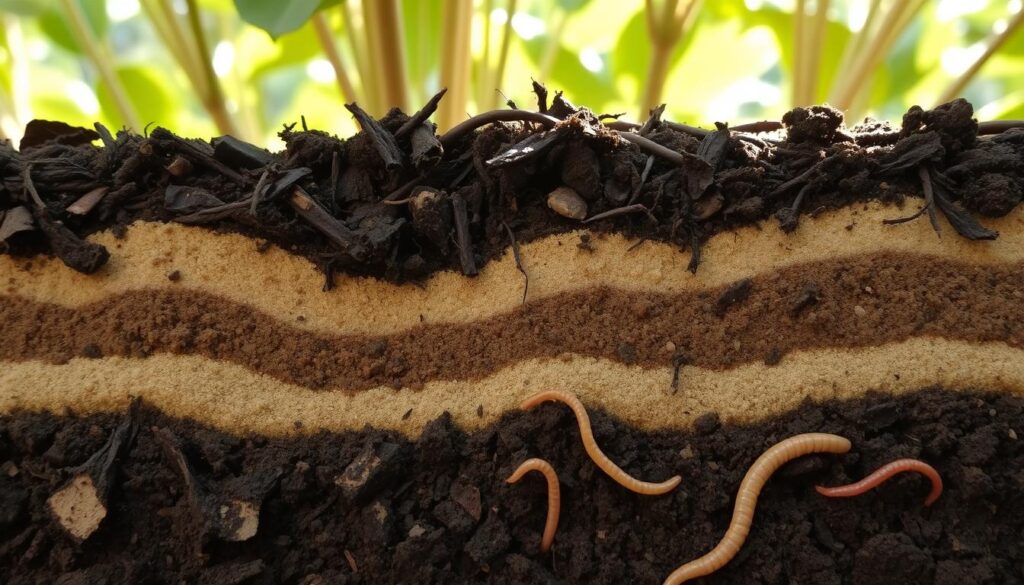
“Well-drained soil is the foundation for a healthy, thriving garden. Invest the time to get your soil right, and your plants will reward you with vibrant growth and vitality.”
Nutrient Deficiencies Causing Plant Drooping
Keeping plants healthy means giving them the right nutrients. Without these, plants can show signs of stress, like droopy leaves. Knowing what nutrients are important and spotting when they’re missing can help fix these problems.
Essential Nutrients for Plant Health
Plants need a mix of big nutrients and small ones to grow well. Big nutrients like nitrogen, phosphorus, and potassium are needed in more amounts. Small nutrients like boron, iron, and calcium are also key.
- Nitrogen helps leaves and stems grow.
- Phosphorus is good for roots and plant strength.
- Potassium makes cells strong and helps plants handle drought.
- Calcium helps with cell walls and getting nutrients.
- Iron is crucial for making chlorophyll and photosynthesis.
Signs of Different Nutrient Deficiencies
Different nutrient problems show up in different ways. Look for slow growth, yellow or discolored leaves, and weak plants. Knowing what’s missing helps fix the problem with the right food or soil changes.
| Nutrient | Deficiency Symptoms | Causes | Solutions |
|---|---|---|---|
| Nitrogen | Yellowing lower leaves, pale green foliage, weak branches | High or low pH, nutrient imbalance, soil depletion | Nitrogen-rich fertilizers, organic matter like compost |
| Phosphorus | Dark green older leaves, potential purple/red tinge, stunted growth | Incorrect pH, nutrient imbalance, extreme cold | Phosphorus-rich additives like superphosphate or bone meal |
| Potassium | Brown or burnt leaf edges, chlorosis between veins, leaf necrosis | Nutrient imbalance, soil depletion, high salt levels | Potassium-specific fertilizers, composted organic matter |
Fixing nutrient problems needs a full plan. This includes checking soil pH, adjusting fertilizers, and making sure plants absorb nutrients well. With the right care, plants stay healthy and strong.
Environmental Stress Factors
Plants face many environmental stressors that can make them droop and get sick. Low humidity and air pollution are big problems. Keeping humidity levels steady, especially for tropical plants, is very important.
Protecting plants from cold drafts and extreme temperatures helps a lot. It’s also good to acclimate them slowly to new places. Cleaning their leaves regularly helps them breathe and grow better.
Lack of water in the soil can make plants wilt, and too much water can harm their roots. Plants may wilt in very hot weather to save water. Sunburn and frost can damage leaves, making them look bad.
“Drought is considered one of the most severe environmental stresses affecting plant productivity, with approximately 80–95% of the fresh biomass of the plant body comprised of water, playing a vital role in various physiological processes.”
Global warming is changing how rain falls, making plants stressed. Warmer air can melt glaciers and flood farms, causing big problems. Plants lose water, affecting people’s lives too.
In areas that rely on rain, droughts are getting worse. Changes in rain patterns make things harder. By 2100, summer rains could drop by 70%, making it hard for plants to adapt.
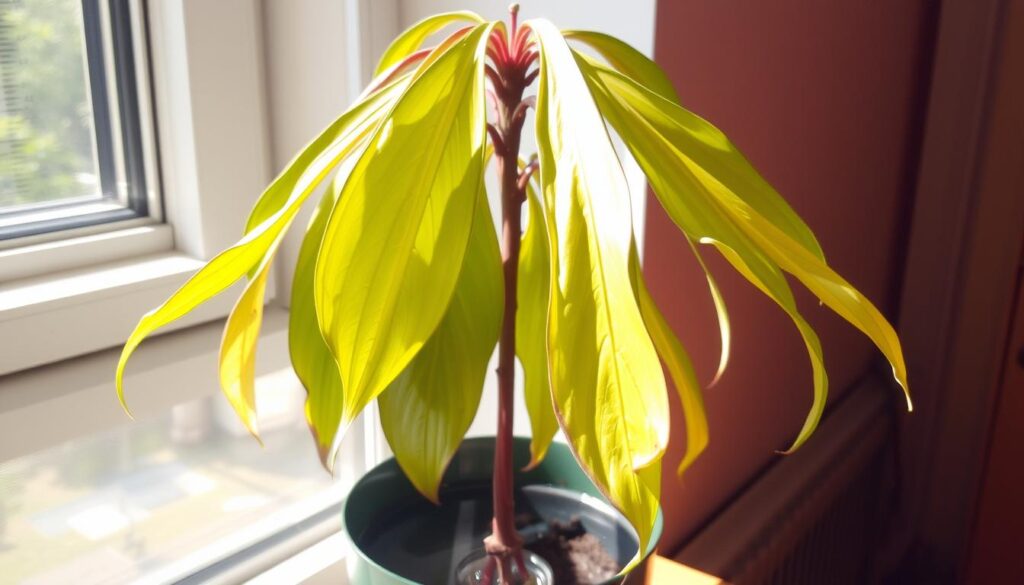
Plant Is Drooping: Step-by-Step Recovery Guide
If your plant is drooping, don’t worry. You can make it healthy again with the right steps. First, find out why it’s drooping and fix it fast. This guide will show you how to care for your plant and bring it back to life.
Assess the Situation
Look closely at your plant. Check for signs of too much or too little water, nutrient problems, or stress. Knowing the cause helps you fix it.
Adjust Watering Practices
Too much or too little water can make plants droop. If the soil is wet, wait until it’s dry before watering again. For a dry plant, water it slowly until the soil is just right.
Optimize Light Exposure
Wrong lighting can also cause drooping. Check if your plant gets enough light. Move it to a brighter or shadier spot if needed.
Prune and Repot
Remove dead leaves and stems to help your plant grow new ones. If the plant is too big for its pot or the soil is bad, repot it with fresh mix.
Provide Appropriate Nutrients
Not getting enough nutrients can make plants weak and droopy. Use a balanced fertilizer to feed your plant and help it recover.
Monitor and Adjust
Keep an eye on your plant as it recovers. Change its care if needed. With care and patience, your plant will be healthy and strong again.
“With the right care and attention, even the most drooping plant can be revived to its former glory.”
Preventive Care and Maintenance
Keeping your plants healthy is key to avoiding droopy leaves. Regular checks and early action are vital. Start by checking the soil moisture often. Make sure it’s moist but not too wet. Change your watering based on the plant’s needs and the season.
Regular Monitoring Tips
Watch your plants for signs of trouble like yellow leaves or spots. Look for pests like spider mites or aphids weekly. These pests can harm your plants and cause them to wilt. Keeping the right humidity can help prevent these problems.
Seasonal Care Adjustments
Change how you care for your plants with the seasons. In winter, water less to avoid too much water. Keep the temperature and light the same to avoid stress. In growing seasons, add more humidity and fertilize often for strong growth. Rotate plants to get even light and help them grow strong.
